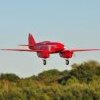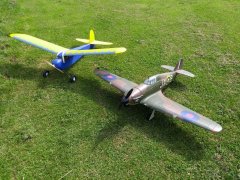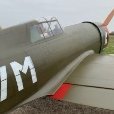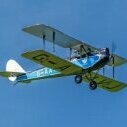Leaderboard
Popular Content
Showing content with the highest reputation on 11/05/21 in all areas
-
I believe that an electric motor should be running for a failsafe test, certainly with some makes of radio, because one of the failsafe options is for the receiver to stop sending pulses on loss of signal. I have ESCs which, in this scenario, will carry on driving the motor at whatever speed they were running when pulses disappeared. So rather than identify which combinations of RX and ESC fall into this trap, it's much easier to test every setup. Restrain model, open the throttle a little then switch off the Tx. For me, only then do I have confidence that the complete setup will do as I expect.7 points
-
5 points
-
Well its been a long time what with lockdown, redundancy and weather but the York has finally flown! How did it go? well a total none event to be honest. A nice straight run out and a nice climb out with plenty of power. It was a pussy cat to be honest, nice and stable and responds nicely to the controls. Two clicks of right aileron trim and that was all. Really impressed with it all round to be honest. Nice one Tony.4 points
-
I am in complete agreement with that, with the added comment regarding point (a) that if you are handling a multi kW glider with ‘motor on a switch’ and a power system rating of only a few seconds at a time static then a power on range test is next to impossible. To check the motor fail-safe on such a system I remove the prop which then needs a lower voltage battery being used to keep rpm within safe limits – I regard that as a workshop job. The point I am making is that range checking and fail-safe checking probably needs be varied according to the characteristics of the model and radio system being used. Dick3 points
-
Try the Logic RC Servo Slow, I just bought it and tested it, works flawlessly, also has 2 chan built into it so you only need 1 module to connect 2 servos, will post vid later ?3 points
-
2 points
-
I'd have thought lepidoptery pin would suffice!2 points
-
2 points
-
While I agree that many things will change in the coming months/years, for me the traders are a large part of the incentive to attend the NATS and, certainly, seeing all the diverse branches of the hobby in one place is a huge attraction (I need my annual fix of the C/L Team Race circle) and, as much as I applaud the NFC, I don't think it could ever be a substitute for somewhere like Barkston Heath. David2 points
-
I usually set up my electric model fail-safe in my workshop with the model restrained on my model stand (usually without a propeller fitted but not necessarily). As Chris says I run the motor as well as hold controls at some extreme position before switching off the transmitter (my Horus hates that because it 'knows' there's a receiver still connected and I have to insist!). My usual fail-safe condition is all controls neutral and motor off. It's an easy and quick check and well worthwhile doing. I choose the neutral control option because it offers the best chance of recovery from a brief signal loss though, I've never experienced a problem in actual operation ... so far .2 points
-
For glueing a balsa LE to a foam wing I use 30min Epoxy. I just wrap masking tape around the LE to hold it in place until cured. I then razor plane/sand the balsa to the final LE profile. I have also used gorilla glue for glueing in ply dihedral braces into foam, just don't use too much Gorilla glue as it foams up and is difficult to sand when cured. Cyno works OK with foam too depending on the foam but foam safe should be OK. I sometimes use it for glueing carbon rods into foam for reinforcement. I usually use a kicker too but fingers sometimes seem to get stuck to the foam!1 point
-
1 point
-
A conservative suggestion John, but a safe, nay, SOLID one. I'll consider that a banker/ fall back option. ?1 point
-
This might seem like a "how long's a piece of string" question, but bear with me... Given recent FASST revelations, I feel that it's time to push the button and go with a TX16. I'm too vulnerable at the moment; my Futaba TX dies and I could be Donald Ducked! So, given that I only have FASST compatible receivers, mostly FrSky, so am happy with non branded gear, what receivers should I buy when I buy my TX16? The world, Rodney, is my lobster, but that tends to lead to option anxiety crises. I'm the same in the breakfast cereal aisle... So, what would you buy if you were me? Thanks all, you're too patient... Graham1 point
-
1 point
-
FMS arrived today and apart from the Rx awaited is ready to go in a lazy 30 mins. Fab quality and design with a very sure 'click' to the mountings and clean alignment. Really pleased with this investment, hope I can do it justice.1 point
-
Mounting the two aileron servos had been bothering me a little as it seemed a bit of a chicken and egg task. On the one hand The servos need mounting and hatch frames fitting prior to sheeting the lower wing but just a small change in angle of the servo seating translates to a larger vertical movement where the torque rod exits the trailing edge of the aileron cut out; just where it needs to accurately mate with the fine fitting box in the aileron. It’s usually challenging enough to construct tight fitting shrouded ailerons without any binding, but the RDS system requires a further step in precision. I decided that an adjustable mount was required and fortunately the KST X10 servos are made in such a way that a solution presented itself. Firstly a 1.5 local ply shear web was added against the outside of rib no.9. Next two soft/light hardwood bearers (Aspen) were added and the three servo holes marked. The small rear bearer was drilled 2.5mm and a 3mm allen bolt was used to create a thread that was hardened with cyano. A nut was spun up to near the top of the bolt and locked with superglue and after dropping this through the lug a nylock nut spun up to lightly kiss the underside. With the two front screws lightly in place the rear bolt can be turned until the servo is about level and from there can be adjusted incrementally up or down to give the optimum exit angle of the torque rod before tightening the front screws. When the wing is complete, glassed and primed and the ailerons glued in place the final adjustment will be made and a small hardwood bearing can be glued to the inside of the trailing edge exit hole to give added support to the torque rod.1 point
-
I had a book from the library before lockdown regarding study into swift behavior. In periods of bad weather the young in the nest go into torpor state with reduced body temperature and can survive for up to two weeks with no or little food. One young was tagged and after leaving the nest was recorded in Spain just two days later! Another factoid from the book- swifts have been timed on the flat at 90mph which makes them if not the fastest must be up there. A peregrine cheats by diving so isn't in the same league. A fascinating bird and deserves our help and encouragement1 point
-
I had a very similar experience to Gary, but luckily it was 'just' an Irvine 53 in my model. I had to tip the model forward to get fuel out at the end of the day and when I dropped it back down the tailplane came to rest on top of the restraint rather than in it. I gave it a tug forward as I usually do and it felt fine, but it was only the tailplane struts that were catching on the restraint, so when I started the engine the plane got loose and made a lunge at me. I tried to stand up to get out of the way but my hand was out in front of me and the prop clipped two fingers on my right hand. I had to visit A&E and go back for a bit of plastic surgery to get the tips reattached. It was only the very ends so it could have been a lot worse. These restraints work very well when used properly and I'd say they are extremely useful. But you do have to use them with care. A contributing factor to my accident was listening to someone who was chatting to me while I worked. I just don't do this now. If I'm working on an engine or plugging in a battery I wait until I am not distracted before I do anything risky. I'll even tell somebody to go away if need be. I'm a rude so and so.1 point
-
Probably applies to most of us ? Dick1 point
-
I've not been to the nats since 2005 so I won't either miss it or wring my hands over it, MOG that I am. If the FF one is on I'll make the trip up. I suspect that the relative ease with which we can obtain hard to come by items cancels out the need to make the trip to buy (or over buy) the supplies we think we need. I'll miss the bring and buy but it's a hell of a way to go just for that.1 point
-
That would certainly stop a flyaway...! I did see someone with a Phantom once bungeeing it to a table to test, ‘’twas quite amusing to watch as they kept twanging free but he did get there in the end!1 point
-
I've clarified the thread title as the thread creep (which did relate to the use of restraints during range testing) will be useful to beginners - and the odd more experienced pilot too!1 point
-
I bought a TX16S and am transferring models from an X9D+ using the cloning feature which is great ? I like the TX16S but one problem I encountered when flying with it in a TX muff is that I found it quite difficult to locate the trims by feel, and as they are black on black on mine I also can't really see them through the Tx muff window! Anyone had similar problems and is there an easy fix?1 point
-
I think the relevant part there is "...as we've known them..." Things have changed, and maybe national-level competitions and events need to change to ease their likelyhood of going ahead. A big trade presence would not be needed at the NFC as it has been paid for (as far as I know); there are fewer overheads for the organisers to cover by getting income from the traders.1 point
-
Small keel and wing seat arrangement, I have constructed this from light ply, rather than balsa and inserted a blind nut here with a little bracing to strengthen this area as I was not happy with the original arrangement.1 point
-
Basically, you are suggesting that your crude ground range test with motor running and not running is better than a standard range test followed by monitoring and recording the signal strength every part second of several test flights going out in every direction and at all sorts of different heights as far as one is able to fly. On top of that you are suggesting that your ground range test is better than getting a signal strength warning on every flight long before a loss of signal? I don't need a written guarantee from elsewhere, I have one instantly from the telemetry of every single flight I've made. Going onto your minimizing the unknowns, components in a receiver can begin to fail in time, or even after a hard landing and component values can drift. On the OCD scale one should do a range test before every flying day for this reason. However, telemetry is constantly monitoring that on mine and an unexpected low signal strength indicator gives an early warning of this. I have actually had this after a hard landing, the loss of signal strength being not enough to really show up on a range test, but enough to affect overall range. Better safe than sorry and the receiver got binned. Your crude range test still has plenty of unknowns, and walking 30 metres is far far less than the 130 metres I range test to, even though my transmitter reduces the signal by the same amount as others on range test. At one time it was the best we had. Today we have far better. Our flying site has a microwave link running directly across it. Would you like to tell me how your ground test ensures that you still have an effective signal strength flying through it? I sometimes get a low signal strength warning when I fly through it. I have to be exactly at the right height to do this, as it appears to be a narrow beam. I can look back at the telemetry and see these low peaks and just how low they get. Thankfully they never get anywhere low enough to lose the signal, but they certainly did with 35MHz gear, and my first Spekrum radio. Incidentally if I do get a low signal strength warning, I can double that distance away from me before the plane will go into failsafe. That is quite some safety margin. I know my system and trust it.1 point
-
The ailerons have been set aside for a final sanding once the lower sheeting and shroud is in place. The key task for inside of the wing is to sort the retract mounts. Naturally I am procrastinating over this and instead have made a start on the pneumatic and flap control systems. The UP3 valve is for the retracts and gear door pneumatic actuators and will be operated with an old glider wing servo I had. This clever piece of engineering has a needle valve for each operation so that doors and wheels can be sequenced and slowed to give more scale like actuation. My tailwheel is mechanically operated so I may be able to put its servo on a Y-lead with this one and use the ‘Servo Slow function on the transmitter so it also has a scale operating speed. The JR Matchbox is for the four flap servos as previously mentioned in this thread. The 900ma LIfe Battery is to tun the flaps only. Not cheap but I am not keen on having to remove batteries for charging as recommended for Lipos. I need to frame the area out for a hatch and add a switch, but it rather looks like I am going to have to get on with mounting those retracts next ?1 point
-
My latest Guillows RC conversion, the Zero, to complement my SBD3. No painting involved this time, just tissue paper (including the canopy and cowl) and printed on tissue paper for the roundels and tail marking. The flaps and gear outline are printed on clear sticker paper, but should have done it on tissue. Lesson for next time.1 point
-
Cheers MattyB. I’ve looked on the site and the link that tells you on the website. I bought up this issue as I’m sure that there are a lot of flyers with Frsky fasst receivers By all accounts, I may just keep my gear now until the 9CAP is not working or gets broken. It’s in perfect working order now. I best get saving!1 point
-
I've visited and flown at Buckminster as well as camped there and it's a great venue but it's nowhere near capable of hosting an event like the Nats as we've known them at Barkston Heath. Individual events would work well but certainly not ones that would attract a big trade presence; Buckminster is simply not big enough and unless members are prepared to support financially a huge facility never likely to be. We need the support of the RAF or the Nats won't happen. Hopefully, 2022 we see their return. Geoff1 point
-
Here's mine, was given to me by a customer/clubmate. Flair Pupeteer.1 point
-
My experience with buzzing digital servos is that the buzzing is significantly reduced when the faster 10ms setting is selected instead of 20ms. I’ve noticed this on a few models and now buzzing is a reminder to me to get into the receiver setup and change the setting.1 point
-
Just finished the latest lockdown project,Rockwell OV10 Bronco scratch built.60in span for electric and Pss.Apologies if this is the wrong forum to post it in.1 point
-
John, a digital servo sends power pulses to the servo's motor at a higher frequency than an analog servo. This digital servo motor control pulse rate (frequency) is distinct from the frequency of the PWM control signal from the receiver to the servo. As Philip says, hearing the buzz is normal, it is likely to be in your comfortable audible frequency range.1 point
-
The Frankenstein cowl, look away those of a nervous disposition! Baffling work, the bit I'm holding is a 'false' bulkhead (part of the old bulkhead) and sits at the back of the engine and has the horizontal baffle attached to it. the horizontal baffle prevents air going over the top of the crankcase. False bulkhead fitted Shot showing front, angled baffle Route that the air is forced to take Doesn't look too bad (from this side) with the cowl in place Bit of a mess from this one though! I will probably remove all of the rather large rivets and replace them with smaller ones when rivet delivery arrives!1 point
-
Jonathan, I have been looking at Paul's build and noticed the wing plate has the holes etched in. The production kits don't, so glue the plates in and drill them later when you line the wing up to the fuselage. A further tip when you come to fit the plate in the fuselage that has the captive nuts on fit them to the plate before gluing it in.1 point









.thumb.jpg.632415da66ae2d3b91c91514c153e5df.jpg)




(2021_02_0818_01_52UTC).JPG.thumb.jpeg.e71d57e599a1c60b93ffa7118b5ffd9a.jpeg)



